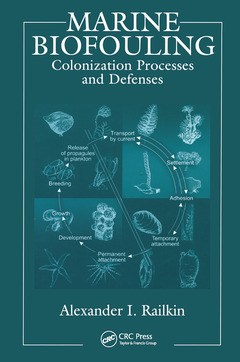Marine Biofouling Colonization Processes and Defenses
Auteur : Railkin Alexander I.

Recent instances of bioinvasion, such as the emergence of the zebra mussel in the American Great Lakes, generated a demand among marine biologists and ecologists for groundbreaking new references that detail how organisms colonize hard substrates, and how to prevent damaging biomass concentrations.
Marine Biofouling: Colonization Processes and Defenses is the English language version of a comprehensive work by eminent Russian scientist Alexander I. Railkin, who details the causes of vast biomass concentrations on submerged hard substrates. He also delivers a quantitative description of colonization processes and provides detailed models for preventing biofouling.
This volume expounds on many topics rarely discussed in the frame of one book: types of hard substrate communities; comparison of hard and soft substrate communities; harm caused by micro- and macrofoulers; larval taxes and drift; mechanisms of settlement and attachment of microorganisms, invertebrates, ascidians and macroalgae; the impact of currents; protection from epibionts; industrial biofouling protection; successions on hard substrates; and the recovery of disturbed communities or the self-assembly of communities. The text includes much Russian-language research translated for the first time.
Through a thorough examination of substrate organisms and an exploration of preventive methods, this monograph prepares those concerned with marine biology to help protect the self-purifying organisms that keep marine ecosystems healthy and productive.
Date de parution : 01-2020
15.6x23.4 cm
Date de parution : 12-2003
Ouvrage de 304 p.
15.6x23.4 cm
Thèmes de Marine Biofouling :
Mots-clés :
NRC Research Press; Sea Water; Aurelia Aurita; Barnacle Semibalanus Balanoides; Hard Substrate Communities; Antifouling Protection; Relative Fouling; Macroalgal Spores; Planktotrophic Larva; Cyprid Larvae; Mussel Mytilus Edulis; Hard Substrates; Semibalanus Balanoides; Lecithotrophic Larvae; Attachment Disc; Soft Ground; Antifouling Coatings; Maximum Swimming Velocity; Byssus Threads; Balanus Amphitrite; Geometrid Moth; Spores Settle; Larval Settlement; Scuba Gear; Organotin Compounds



